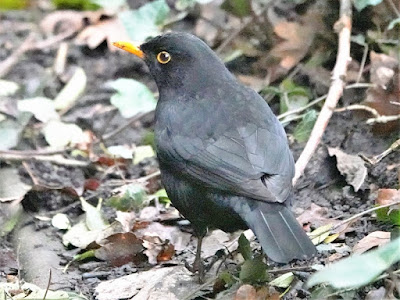2.0°C > 4.0°C: Overcast yet again. Moderate easterly wind. Very good visibility.
[Sunrise: 07:30 GMT]
"Poor weather" itinerary yet again. I could get used to the late starts but probably not the grey skies.
No more dead or unwell-looking geese seen thank goodness. I note the lock-down on poultry is to be extended from Shropshire to include Herefordshire, Worcestershire, Cheshire, Merseyside and Lancashire. Can Staffordshire, just five miles from here as the goose flies, be far behind?
* = a species photographed today
Priorslee Balancing Lake: 10:45 – 12:30
(37th visit of the year)
Bird notes:
- only three pairs of Gadwall noted.
- a Water Rail seen in the Wesley Brook near the footbridge.
- as seems to be normal at the moment almost all the Herring Gulls were immatures and almost all the Lesser Black-backed Gulls were adults.
- neither Grey Heron nor Great (White) Egret were present again.
Bird(s) noted flying over here:
None
Counts from the lake area:
- 14 Canada Geese: three of these arrived together
- 2 Mute Swans
- 6 (3♂) Gadwall
- 9 (6♂) Mallard
- 25 (15♂) Tufted Duck
- 1 Water Rail
- 8 Moorhens
- 124 Coots
- *3 Great Crested Grebes
The gull counts are given as two figures: the first as I arrived // the second as I was about to leave. Other gulls would likely have been and gone in between.
- 34 // 51 Black-headed Gulls
- *4 // 28 Herring Gulls
- 0 / 1 Yellow-legged Gull
- *5 // 94 Lesser Black-backed Gulls
- *5 Cormorants: of these three arrived as a single and a duo
- 1 Kingfisher
Of note:
Counts from the lake area:
- 14 Canada Geese: three of these arrived together
- 2 Mute Swans
- 6 (3♂) Gadwall
- 9 (6♂) Mallard
- 25 (15♂) Tufted Duck
- 1 Water Rail
- 8 Moorhens
- 124 Coots
- *3 Great Crested Grebes
The gull counts are given as two figures: the first as I arrived // the second as I was about to leave. Other gulls would likely have been and gone in between.
- 34 // 51 Black-headed Gulls
- *4 // 28 Herring Gulls
- 0 / 1 Yellow-legged Gull
- *5 // 94 Lesser Black-backed Gulls
- *5 Cormorants: of these three arrived as a single and a duo
- 1 Kingfisher
Of note:
Nothing else
These two Great Crested Grebes are acting like a pair...
...with their strange head-shaking display.
Whereas this one isn't paired.
One of the immature Herring Gulls spent time playing with objects (food?), attracting the attentions of the other gulls – here an adult Lesser Black-backed Gull.
Quite a mouthful. I assume it is not heavy!
A first year Lesser Black-backed Gull tries its luck at grabbing for the item, whatever it is.
Very aerobatic!
If you think the Herring Gull is making its escape...
...think again. A protesting second year Herring Gull joins in. They all then flew too high and far away for me to capture what happened next.
A first year Lesser Black-backed Gull.
An unusually pale Cormorant. I assume a first year bird.
Here standing on the "boxing ring". Note that they are darker black (if that makes any sense) around the eye.
A flight shot as I went too close and they retreated.
(Ed Wilson)
------------------------------------------------------------------------------------------------------
The Flash: 09:25 – 10:35
(34th visit of the year)
Bird notes:
- the two drake Shoveler still here.
- a Water Rail was heard calling at the top end.
- a kind person was feeding the birds. I cannot recall seeing such a scramble by the Coots with 24 of them attempting to grab something. Even a few Tufted Duck were flying in from the other end of the water. I guess the birds are hungry in this cold weather. These species are all vegetarian: not much will be growing at the moment.
Bird(s) noted flying over here:
- 2 Herring Gulls
- 1 Lesser Black-backed Gull
Noted on / around the water:
- 15 Canada Geese
- 4 Mute Swans
- 2 (2♂) Shoveler
- 32 (21♂) Mallard
- *4 (3♂) Pochard
- 58 (34♂) Tufted Duck
- 1 Water Rail: heard only
- 18 Moorhens
- 35 Coots
- 56 Black-headed Gulls
- 3 Herring Gulls: two adults; one second year
- 1 Cormorant
Noted elsewhere:
- 1 cranefly Limonia nubeculosa
Another attempt to show the fine vermiculations on the back of drake Pochard.
Male Blackbirds may already be on nest duty and this multi-brooded species often starts as early as February. He has the bright yellow bill and eye-ring of a breeding condition male bird.
A pair of Bullfinches, the brighter male on the right.
The male flew off. The female stayed eating buds.
(Ed Wilson)
-----------------------------------------------------------------------------------------------------
Priorslee Lake
1 Velvet Scoter
3 Greater Scaup
(Observer Unknown)
2013
Candles landfill / Horsehay Pool
1 Iceland Gull
3 Caspian Gull
8 Yellow-legged Gull
Herring x Lesser Black-backed gull hybrid
(Tom Lowe)
2012
Priorslee Lake
1000+ large gulls
2 Iceland Gulls
3 Yellow-legged Gulls
(Tom Lowe)
2010
Priorslee Lake
1 Little Grebe
4 Great Crested Grebes
4 Gadwall
39 Pochard
84 Tufted Duck
1 Water Rail
173 Coots
1 Siskin
(Ed Wilson)
2009
Priorslee Lake
Iceland Gull
(Observer Unknown)
2008
Priorslee Lake
Glaucous Gull
(Geoff Holmes)
2006
Priorslee Lake
10 Pink-footed Geese
c.70 Golden Plover
80 Fieldfares
10 Great Crested Grebes
10 Pink-footed Geese
10 Pochard
38 Tufted Ducks
151 Coots
1 Water Rail
1065 Wood Pigeons
273 Jackdaws
186 Rooks
400 Starling
27 Robins
23 Blackbirds
10 Song Thrushes
11 Greenfinches
48 Siskins
1 Redpoll
10 Reed Buntings
(Ed Wilson)






















